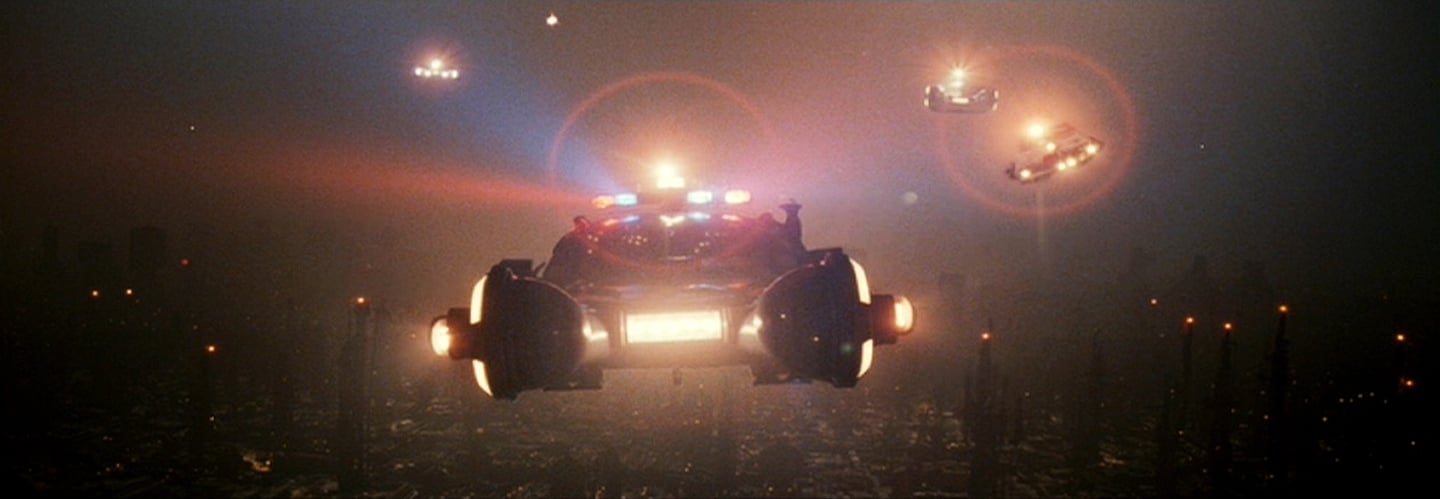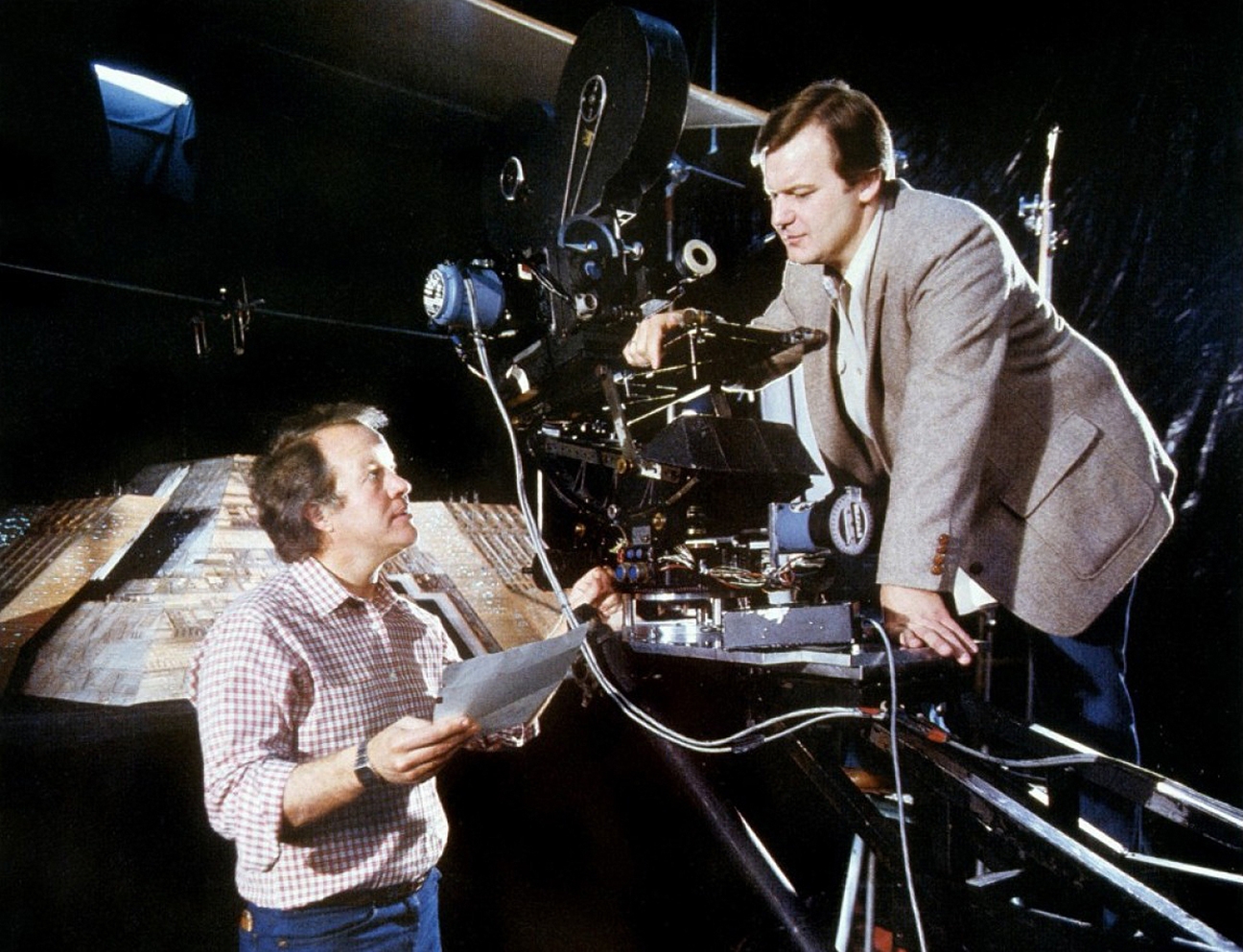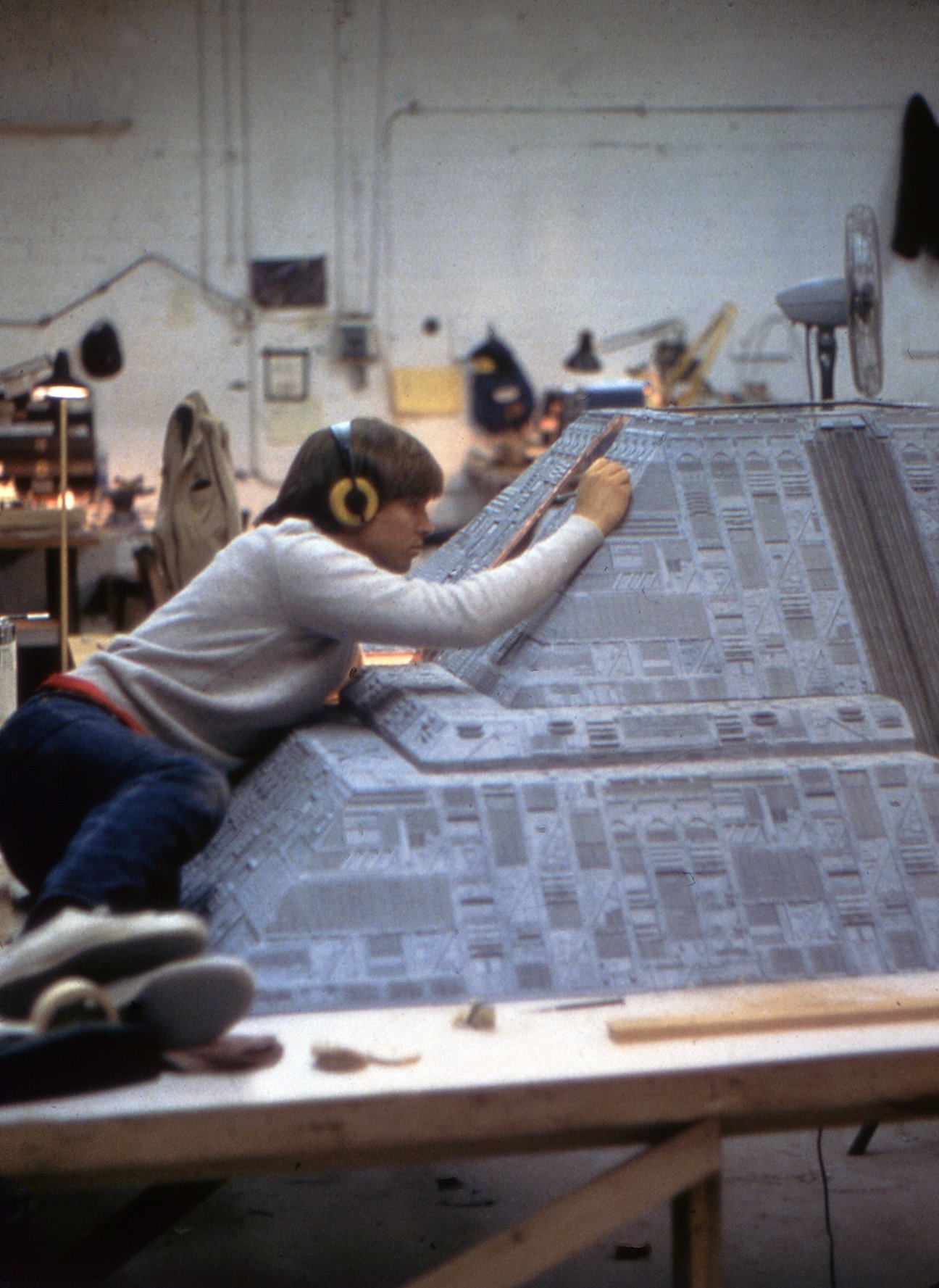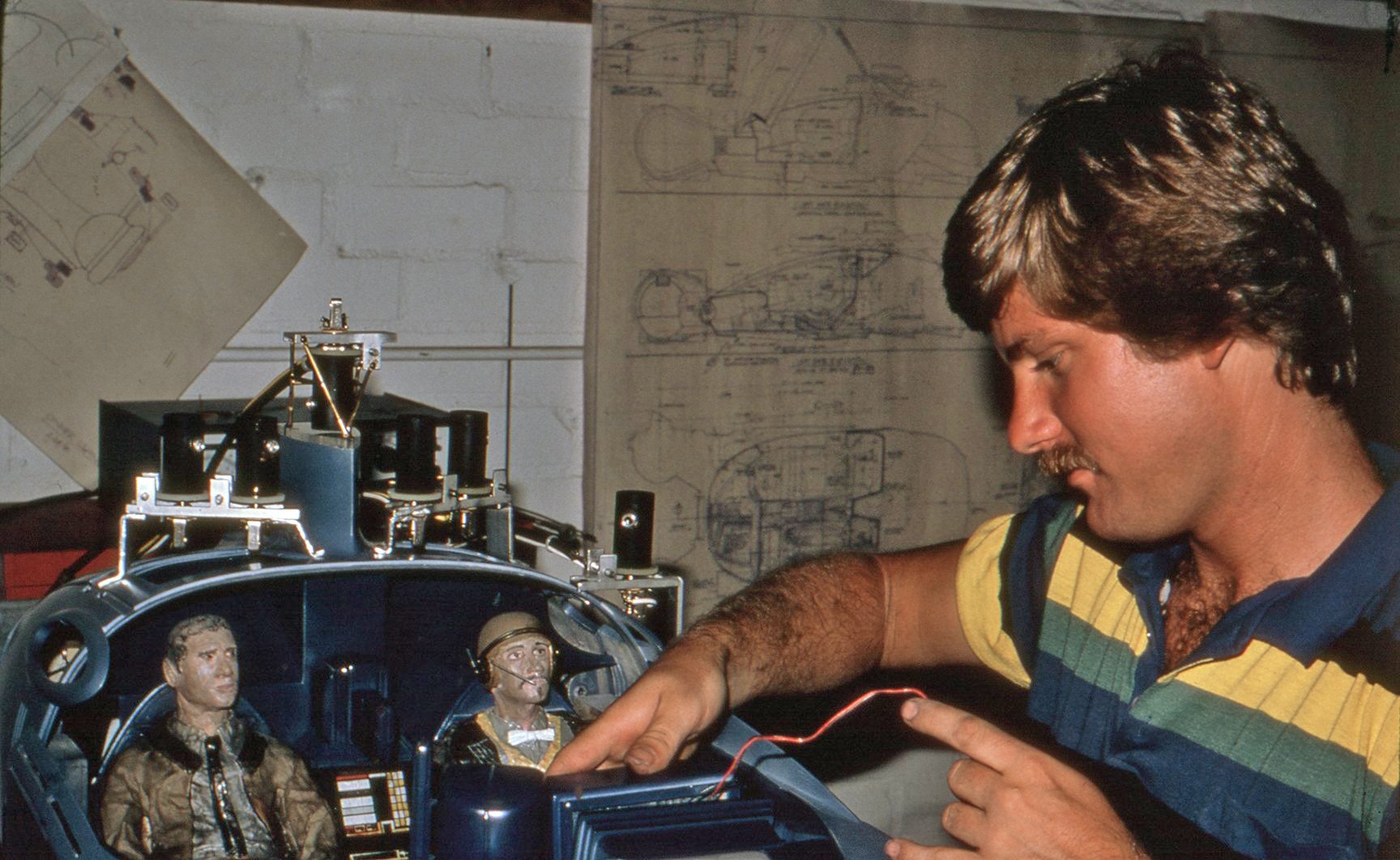
Blade Runner: Special Photographic Effects
An interview with special photographic effects supervisor details some of the techniques used to create the film’s outstanding visuals.
Editor’s Note: The author was one of three special photographic effects supervisors for Blade Runner along with Douglas Trumbull and Richard Yuricich. He is a Phi Beta Kappa graduate of the USC film department and has worked as a documentary editor and as a director of commercials involving sophisticated visual effects.

The special photographic effects for Blade Runner were executed by Entertainment Effects Group (EEG), which is a partnership between Douglas Trumbull and Richard Yuricich. We had a crew of over 50 people involved in miniature work, matte painting, optical compositing and some front projection. The miniature photography extended over a period of about 10 months, starting more or less concurrently with the live action photography. There were over 90 special effects shots made for Blade Runner. Not all of them ended up in the picture, but most of them were quite successful. They varied from simple scenes composited from perhaps three elements to complex shots involving 35 or 40 elements, not counting the positive and negative mattes for each element.

Except for some high-speed 35mm photography of explosions, all of the special effects work was done in 65mm. (The negative is 65mm while the print is 70mm.) Douglas prefers working in 65mm to 35mm or VistaVision, and he recommended doing all the effects in 65mm at the outset of the project as a means of maintaining image quality. Using the larger format reduces the grain buildup, so that you don’t have the thing that you see in a lot of effects films where you can always recognize an effects shot because it suddenly gets very grainy. Anytime a live-action scene in Blade Runner was designed to have effects added to it later, it was shot in 65mm, as were the miniatures. Judging from the tests I’ve seen, the quality of the effects shots should match brilliantly with the rest of the live-action footage, even though we sometimes had to go through five generations in the optical work in order to get the effect we wanted.
Douglas also prefers motion control to bluescreen work. He has found that bluescreen is an adequate technique for hard-edged mattes, but doesn’t quite provide the clarity he wants. He prefers to use frontlight/backlight to pull mattes off using a second pass. The motion-control system used for Blade Runner was essentially the same as the one used for Star Trek and Close Encounters, affectionately known as the “Ice Box.” It has at least eight channels of control. It can pan a camera, tilt it, follow focus, track in and out, and boom up and down. Depending on the shot, you can feed several channels of information to the stepper motors for each pass of the camera. If you are going back on an additional pass to double expose over the original negative — which we did a lot — you can program new information into any channel that is not being used to control the move and create, for example, a light that rotates at a certain speed.
“The real key to doing the special effects on this or any other picture is the experience and ingenuity of the people involved. It is not the equipment.”
— David Dryer




We did some shots where the film was in the camera maybe three days solid doing multiple passes. We had one instance where the Department of Water and Power did us a real favor. After being in a shot three days (and behind schedule to boot), they decided to shut down for a millisecond. When they did, the computer ran away, and the camera, which weighs about 70 pounds, suddenly on its gimbal just started to go over. We had to hit the panic button, dump it all and go back and start all over again. It would be nice to have our own generator so that we could insure that the power was always there and constant. We also had an earthquake in the middle of a shot, which caused some buildings to move so that they didn’t match up to the other passes we made!
Another technique which Douglas likes to use is the Smoke Room. He has found out by experimenting that one of the mistakes a lot of effects people make is to shoot a miniature in a clear room. Without smoke you don’t get the aerial perspective that you get in atmosphere. Even the purest of atmospheres creates an aerial perspective.

Colors become less distinct; there is a blending and a softening of resolution the further and further away you get. Smoke is a microcosm. It creates the illusion of distance and can make a miniature which is 12' away seem much further away. So in addition to matching the smoke effects used in the live-action photography, we used smoke for almost all the major city-scapes or industrial landscapes. Even the flying machines were often shot in smoke to add depth and create a sense of aerial perspective.



In addition to the Smoke Room, another technique we used to enhance the aerial perspective with a flying object which was being optically composited with a background was to systematically subtract exposure and actually start to drop the matte away as the object receded into the distance. This caused it to become contaminated by the background as it got further and further away from camera and to become less and less bright. It tended to give the feeling of going off into the smoke or haze. Otherwise if the object retains its brightness and resolution as it recedes, it tends to look like a postage stamp stuck on top of the background and doesn’t seem really to belong in the scene.
Another key ingredient in our miniature photography was the use of interactive lighting. If you shoot two elements for a scene and one of them involves some kind of light source or a reflective surface, the lighting of one has got to be affected by what is happening in the other. We tried to keep track of that all the time. For example, when an explosion was to be added to a shot of a [cityscape] tower, we would have a little inky light focused up into a dental mirror which would reflect back down onto the miniature tower. The computer for the motion control system would then ramp that light up and ramp it back down on the proper frames of the shot. This would make the tower glow a little bit coincidental with the explosion in the final shot. Similarly if there was a searchlight involved in a shot of a vehicle flying through the city, we would alter the lighting of the appropriate elements to give the effect of the searchlight hitting the vehicle or a building at the proper moment.
Work on special effects for Blade Runner started long before I got involved in the project with meetings between Douglas, Richard Yuricich, Ridley Scott (the director) and Ivor Powell (the associate producer). The designers were brought in, and then work began on the matte paintings and miniatures. They figured out what scale they wanted to work in and began making the Pyramid and the industrial landscape that we see at the beginning of the film. About one-third of the way into principal photography, Douglas was called away to work on his own film, Brainstorm. That was the point at which I became involved.
Work on the special effects evolved as the production progressed. Scales for the miniatures would change because of different necessities. Even as Ridley started to do the live action, it became apparent that we needed different shots than were originally anticipated. About a third of the special effects shots grew out of what was necessary in terms of what was being shot in the live action stages. One of the most difficult things for an effects supervisor is keeping in touch with what was happening on the first unit. I made it my job to get over to the live-action set as much as possible, to be in on meetings and to see what was happening.
Because as much as everyone on the first unit wants information to get to us, it is very difficult sometimes to have the information filter down. I went through some rather incredible weeks where I’d work three days, 24 hours straight, trying to stay with their night shooting and our day shooting. It was the only way I felt I could stay on top of what was going on well enough to shoot effects so that when the whole film was put together people would not be sure where one stops and the other begins. I think there are some live action shots that people will say, “Look at that, Charlie, isn’t that a terrific effect?” And there are some effects shots where people won’t have the foggiest idea that it was an effects shot. And that’s how it should be, although I sometimes suspect that we do ourselves a disservice if we are too clever and no one notices the effects work in a picture.

Matthew Yuricich was the matte artist for Blade Runner and he started very early in the project. In fact, he did a matte painting of the pyramid that was intended to be seen through the windows of Tyrell’s office. They wanted to front project the image of the pyramid behind the actors so they wouldn’t have travelling matte problems. At that point, however, we were racing to complete the miniature before principal photography began, and that was one of the first sequences scheduled to be shot. So Matthew Yuricich started on a matte painting. It turned out the matte painting was not used. What we did was shoot an 8x10 still of the miniature which was front projected so that it carried up above the heads of the actors. Later the live action shot was combined with a matte painting which even goes in and touches up areas of the room that are a little dark or needed an added touch of some sort. Then we double exposed flying objects into the background.
There were other scenes in the film which would have been ideal for front projection, except that the production schedule was such that we could not have the optical elements ready in time to make the footage for projection. We would just have to shoot the live action against a blank background and then pull a matte off the shot by rotoscoping or whatever. The interiors of the Spinners, for example, were shot without any backgrounds. We drew a matte line for the window by rotoscoping the shot and then created a matte. We then took the window from the vehicle and mounted it on C-stands in the exact position relative to the lens that it had in the live action shot. We measured it all very carefully. Our composited flying shot was rear projected onto a big screen behind the window, and we threw rain and smoke onto the window during the shot. We even worked in some interactive lighting to match our miniature shot. The shot of the window was then matted into the original shot where the original window had been.



David Stewart was director of miniature photography, and his crew started running tests on the models as soon as they became ready. They would expose a piece, look at it, wedge test it and set up exposures for the different kinds of fiber optic lights and so forth. Everything had to be tested. The Spinner, for example, was built in four different sizes and had to be tested in a variety of applications. The scale ranged from ¼" to the foot to something considerably smaller. Some of the vehicles were 1" long, some were 4" long, some were 18" long and some were 4½' long. Depending on the kind of shot and whether the vehicle was to be placed into a miniature set or optically composited with something, a different size might be called for. If we weren’t getting in too close, we’d fly by the 18" model rather than the big model because the bigger model was more awkward to work with and it was difficult to get the camera far enough back. We could use a 16.5 or 17.5mm lens, which is a very wide lens with a 65mm camera.
One of the miniature buildings, incidentally, was actually a space ship from another movie which was reworked into a building for Blade Runner. You can’t tell it when you see it in the film, but we had the shape which seemed appropriate, and we figured we might as well make use of it.

Ridley Scott worked fairly closely with David in the photography of the miniatures. He would come down occasionally and start a set-up on a shot that we would then follow through on. He really had some terrific ideas in terms of how to backlight things and create kick glances and things like that. People involved in miniature photography know about these kinds of lighting techniques, but they aren’t constantly thinking that way. He got us to use live-action lighting techniques and to take what seemed to me to be a fresher approach in shooting the miniatures.


Bob Hall was in charge of the optical crew, and they did a terrific job in combining and shrinking mattes and testing and blending. To my mind they are more artists than technical people because, as Bob keeps pointing out to me, it is not an optical printer; it’s an optical camera. What they do is re-photograph something that has already been built and photographed and make it even better. They will blend and soften and add — almost like shooting on stage. They are essentially adding gobos and gauze and doing all kinds of things to create a look that’s even greater than the initial look that we came up with.

The explosions composited with the miniature shots [for the cityscape] were photographed high speed either in the parking lot here or out in the desert for the really big ones. We would select the pieces that we thought would work best and were scaled properly to the size shot we were working with. Then we would project the footage onto a white card positioned behind a tower in the miniature set so that the explosion appeared to come out of the top of the tower, and we would rephotograph it with the motion-control camera repeating the move it had done on the miniature set. The towers in the miniature are only 3" to 7" high. We would shoot six or seven explosions in this manner in multiple passes to produce a shot with just the six or seven explosions in it. This element would be combined with the shot of the miniature using a low-density matte so that the explosions blocked out some of the lights in the background. Smoke and flame have substance, but they are somewhat translucent; and we had to find just the right level of translucency.
A lot of the live action footage for Blade Runner involved smoke and rain, and matching this material was quite a challenge. You can’t just combine a live action shot involving smoke or rain with a matte shot or a miniature shot and hope to match the smoke or rain. The only way is to shoot the live action shot clean and then add smoke or rain to the whole scene as part of the optical work. This was a problem on the set sometimes, because they were often trying to shoot three camera and cover other angles at the same time we were getting our effects shot. So we always had to say, “OK, now can we just have one take without the smoke and without the rain.” Somebody would always try to sneak the smoke back in for another camera, but eventually we would get a scene that was clean. Then we would do a matte painting for it or add a miniature to it or sometimes both. We might have a matte painting blending a miniature to live action — all relatively clean at this point.

Now in order to add rain or smoke to a scene optically you’ve got to shoot the rain or smoke against a black background. Shooting rain against black is very difficult to do. First of all you have got to create a black that is big enough to shoot the rain against, and then you have to backlight the rain so that you can see it. We managed to create black areas in the parking lot here and at The Burbank Studios by draping off areas, and we shot background rain, medium rain, and foreground rain for every camera angle we had to match.
Even once we had the rain our problems were not over. You can’t just double expose it into the scene. It always looks like a curtain. I remember sitting in a picture one time that had snow in a scene. Obviously it hadn’t been snowing when the scene was shot, and someone had said, “Well, gee, we’ll just double expose snowflakes, and it’ll look like it’s snowing.” Well it always looked like it was right out in front of the screen, and I got angry at having to look through it. I thought, “Why don’t they just take that away and let me see what is going on there because it obviously isn’t part of the picture. It’s not falling on the people.”
One way we sought to avoid this was by setting up little sprinkle spurts to make water drops in puddles when the live-action shot was done without full rain. Then, in optically compositing the rain, we came up with a scheme which I don’t think has ever been tried before. We would make a low-contrast black-and-white print of the composited scene to which we wanted to add the rain, and then we would run that print either in bi-pack or in front of the optical negative going through the optical camera with the rain that we had already shot. What that would do was hold back the rain on the dark areas of the scene and print it through only in the light areas. The net effect is that in the final scene the rain only shows up where it would be back-lit — which is exactly what happens with real rain. As soon as we did that, the rain seemed to drop back into the scenes. Even though it has been added on top, your eye fools you; and you believe that it’s down the street and off in the distance.
The real key to doing the special effects on this or any other picture is the experience and ingenuity of the people involved. It is not the equipment. The camera we’re using is 2BFC Mitchell #3. That’s the third 65mm Mitchell ever built, and it has to be at least 30 years old. The two most often used tools here are the C-stand and gaffer’s tape. If you took those away from us, we’d be in serious trouble, because special effects work is still basic filmmaking. I know there are other effects houses that have more up-to-date equipment — laser printers and all kinds of things now — and I applaud that. But one of the things I’ve really appreciated here is that in every department there were people who were just good basic filmmakers — who were very logical, had a good sense of design and went about doing their jobs. And they delivered time after time after time. We came in $5,000 under budget for our effects work, and I can’t think of another major effects film where that’s happened. We were able to do it because Diana Gold, the visual effects auditor, and I constantly kept track of the budget; and because, whenever I’d go to the guys here and ask them how long it was going to take to do something, they’d give me an honest, accurate answer. [Effects cinematographer] David Stewart is a prime example. They call him “One-Take Stewart” because he knows what will work and what won’t work, what you can get away with and what you can’t. He can shoot it right the first time, where a lot of other crews around this town would have to shoot three and four and five takes. It’s people like him that make it possible for us to do the kind of work we were able to on Blade Runner.



The most rewarding thing that has happened to me in this business occurred one day when Philip Dick, who wrote the novel on which Blade Runner was based, came down to see some scenes that we had been working on. He sat down and was very quiet; and, when the lights came on after we screened some scenes for him, he sat in the chair and didn’t say a word.” I said to myself, “Boy are we in trouble.” After a while he finally said, “I can’t believe it. You guys climbed right inside my head. That’s exactly what I felt when I wrote that. It’s just the feeling I had.” Even things like the Blimp, which weren’t in his book, were apparently right on the feeling that he had. You can’t ask for much more gratifying feedback than that.”
For their work in Blade Runner, Trumbull, Yuricich and Dryer earned Academy Award nominations for Best Visual Effects.
Yuricich and David K. Stewart both later became members of the ASC.
Trumbull was honored with the ASC Presidents Award in 1996.
You'll find our story on Jordan Cronenweth’s cinematography here, and futurist Syd Mead's production illustration work here.
If you enjoy archival and retrospective articles on classic and influential films, you'll find more AC historical coverage here.






